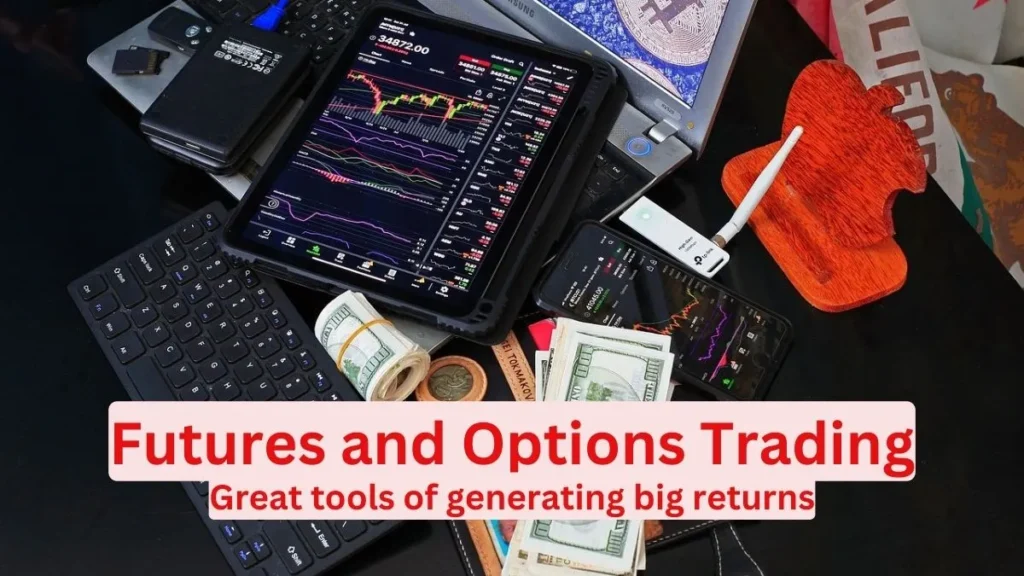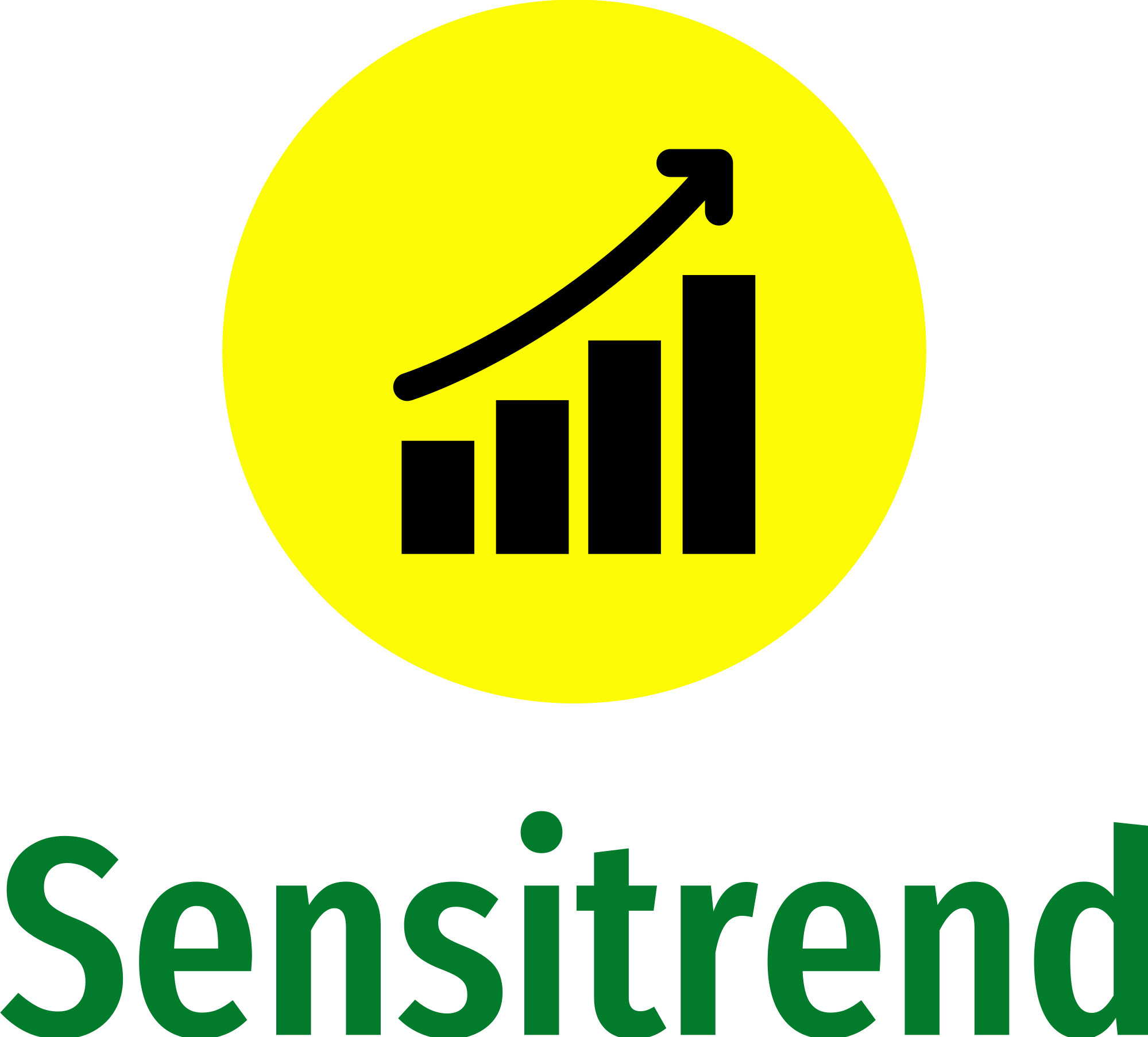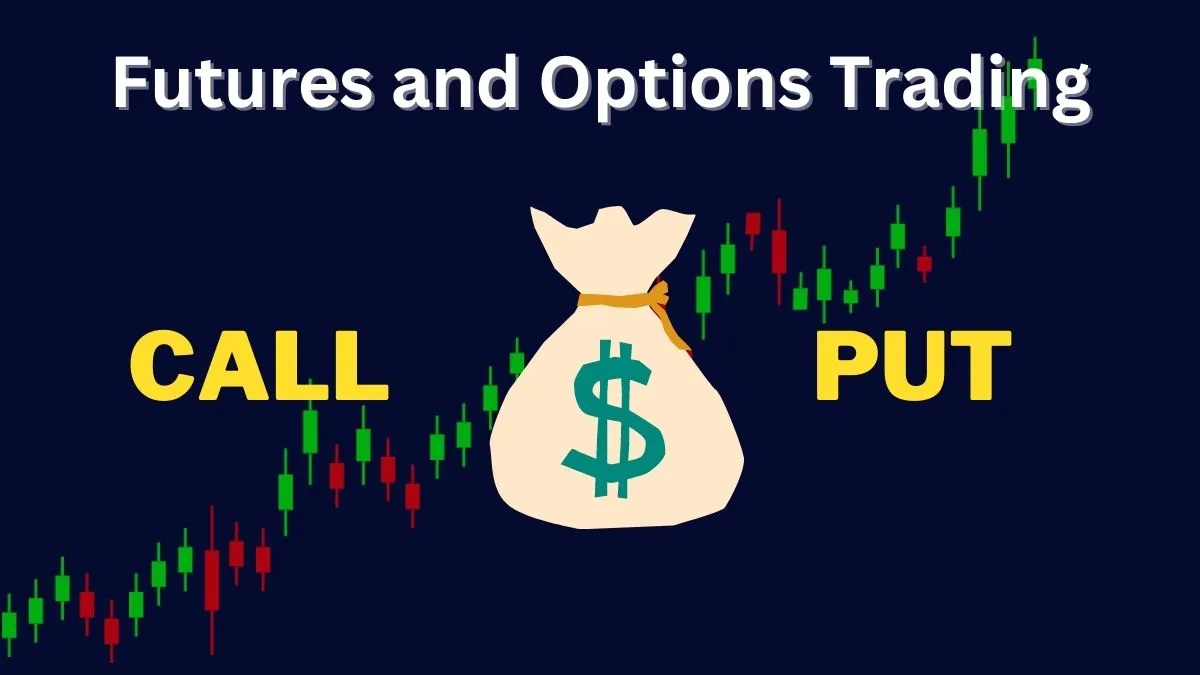- Introduction
- What is Futures and Options Trading
- What is a Future?
- What is an Option?
- Advantages of Futures and Options Trading
- Key Differences
- Key Considerations for Futures and Options Trading
- Strategies for Maximizing Profits in Futures and Options Trading
- Who Should Invest in Futures and Options Trading?
- Tips for Reducing Risk in Futures and Options Trading
- What Factors Drive Futures and Options Prices
- Why Options Trading is Popular Among Traders
- Why do options traders lose money frequently?
- Frequently Asked Questions
- Conclusion
Introduction
Futures and options trading: Are you looking for a way to boost your investment profits and step up your trading game? Look no further than futures and options (F&O) trading. This innovative method allows you to profit from changes in the prices of stocks, indexes, commodities, and currencies.
F&O trading allows you to profit from market movements by buying and selling contracts that give you the right to purchase or sell an asset at a fixed price in the future. This strategy has the potential to yield substantial rewards.
Maximizing profits in the stock market requires quick thinking, expert knowledge, and rapid decision-making. F&O Trading provides all this, allowing you to take advantage of market fluctuations.
This guide is the ultimate resource for anyone interested in F&O trading. You’ll learn the differences between futures and options, the benefits and risks involved, and how to approach this investment strategy with caution. Whether you’re a seasoned investor or just starting out, this guide will give you the tools you need to succeed in the fast-paced world of F&O trading.
So, don’t wait any longer to take control of your investment portfolio and start maximizing your profits. Join us on this exciting journey and discover the world of F&O trading!

What is Futures and Options Trading
Futures and Options (F&O) trading lets traders profit from the changes in the price of underlying assets like stocks, commodities, and currencies. You buy and sell contracts that give you the right to purchase or sell an asset at a predetermined price on a future date.
Futures are standardized contracts that trade on exchanges and help you lock in a price for a future purchase or sale. Options are similar, but they only give you the right to buy or sell the underlying asset at a predetermined price.
To succeed in F&O trading, you must be quick-thinking and make fast decisions. You constantly need to monitor market conditions and adjust your positions. But remember, F&O trading is speculative and risky. You bet on the market direction without holding the underlying asset.
So, it’s crucial to understand the market before you start F&O trading. With the right approach and good market knowledge, you can make informed decisions and potentially reap substantial rewards. But, always approach F&O trading with caution.
What is a Future?
A future contract is a binding agreement that allows an investor to purchase or sell an underlying asset at a predetermined price on a specific future date. As a derivative, the value of the contract is tied to the price of the underlying asset. These contracts are traded on exchanges and serve as a tool for investors to secure a future price for the asset they want to buy or sell.
Futures trading offers two basic positions: long and short. A trader takes a “long” position when they expect the price of the underlying asset to rise and buy a futures contract. For example, a trader who thinks gold prices will increase can buy a gold futures contract and go long. If the price rises, the trader sells for a profit.
A trader takes a “short” position when they expect the price of the underlying asset to decrease and sell a futures contract. For example, if a trader thinks crude oil prices will fall, they sell a crude oil futures contract and go short. If the price decreases, the trader buys back the contract at a lower price for a profit.
Note that a trader can take a long or short position without owning the underlying asset, making futures trading a speculative and risky investment.
What is an Option?
Options are contracts that give you the right but not the obligation to buy or sell an asset. The asset can be anything from stocks, commodities, and currencies to indices. The price at which you can buy or sell the asset is set in advance and is called the “strike price.”
There are two types of options: call options and put options.
- Call options let you buy the asset at the strike price.
- Put options that let you sell the asset at the strike price.
A call option allows the buyer to buy an asset at a set price. A put option allows the buyer to sell an asset at a set price.
People use options for different reasons, such as reducing market risk, betting on the future price of an asset, and making income. Options can be complicated and carry risks. Make sure you fully understand the rules and risks before starting to trade options.
Advantages of Futures and Options Trading
Futures and options are popular financial instruments for a number of reasons. They provide investors with the ability to hedge against market risks, lock in profits, and diversify their portfolios.
One of the biggest advantages of futures is that they allow investors to lock in a price for a future purchase or sale of an underlying asset. This helps to mitigate the risk of price fluctuations and ensures that investors are protected against potential losses.
Options provide investors with even greater flexibility and versatility. They give investors the right, but not the obligation, to buy or sell an underlying asset, which allows them to make informed investment decisions based on their individual circumstances. Additionally, options can be used to generate income and to hedge against market risks.
What is the difference between Futures and Options?
Futures and options are both financial instruments used to hedge against risk and speculate on market movements. They have similarities but also distinct differences that make them suitable for different investment strategies. In this article, we will examine the differences between futures and options and help you determine which one is right for you.
Key Differences
- Obligation vs Right: Futures contracts are obligations to buy or sell an underlying asset at a predetermined price, while options contracts give the holder the right, but not the obligation, to buy or sell the underlying asset.
- Premium: Options contracts come with a premium, which is the price that the buyer pays for the option. Futures contracts do not have a premium.
- Expiration: Options contracts have a limited lifespan and expire on a predetermined date, while futures contracts can remain open until the expiration date or can be closed out before that date.
- Margin Requirements: Futures contracts require traders to put up a significant amount of margin to trade, while options contracts only require the premium to be paid upfront.
- Potential Loss: In futures trading, potential losses are unlimited, while potential losses in options trading are limited to the premium paid.
Key Considerations for Futures and Options Trading
Consider your financial objectives, risk tolerance, and investment experience carefully before starting to trade futures and options. This will help you choose a strategy that aligns with your goals and risk tolerance, increasing your chances of success. Here are a few key considerations for beginners:
- Before you start trading futures and options, it’s important to understand your financial goals. Do you want to generate passive income, grow your wealth, or protect your assets? Knowing your goals will help you choose the right trading strategy.
- Futures and options trading is risky, so make sure you’re comfortable with the possibility of losing money. If you’re not, this may not be the right investment choice for you.
- To be successful, you need to educate yourself on the market and the factors that affect asset prices. Do your research and learn about futures and options trading. Consider taking a course or working with a mentor to gain knowledge and experience.
Strategies for Maximizing Profits in Futures and Options Trading
Now that you understand the basics of futures and options trading, let’s look at some ways to make the most money. To increase your profits in this type of trading, you can employ a variety of strategies. Here are a few to consider:
Long Option Trading:
Options trading offers a way to speculate on the direction of an underlying asset. Buy call options if you think the asset will increase in value. Buy put options if you think it will decrease.
Long option traders hope to make a profit by selling options when the underlying asset rises in value. They buy call options with a strike price they think the asset will reach. If the asset does reach that price, the trader exercises the option and sells the CALL option at the higher market price.
Put option traders hope to make a profit when the asset decreases in value. They buy put options with a lower strike price. If the asset does decrease to the strike price or below it, the trader exercises the option and sells the PUT option at a higher price.
Short Option Trading:
Selling call-and-put options is a way to earn money from options trading. When you sell a call option, you’re making a bet that the price of the underlying asset won’t rise above the strike price. If the price stays below the strike price, you’ll keep the premium you received for selling the option as profit. But if the price of the underlying asset does rise above the strike price, you may end up losing money. Selling a call option means you have a pessimistic or bearish outlook on the market
Similarly, when you sell a put option, you’re betting that the price of the underlying asset won’t fall below a certain price, known as the strike price. If the price stays above the strike price, you’ll keep the premium you received for selling the option as profit. However, if the price does go down below the strike price, the buyer of the option can sell the underlying asset at the strike price and you may end up with a loss. Selling a put option means you are expressing a bullish outlook on the market
Covered Option Trading
Covered options trading is a strategy where an investor holds a long position in an underlying asset and simultaneously sells a call option on the same asset. The call option gives the buyer the right, but not the obligation, to purchase the underlying asset at a specified price (strike price) within a specified time frame.
Here’s a simple explanation of a covered call option:
- You own 5,000 shares of ‘ABC’ company at $50 each.
- You want to earn extra money and still keep your stock for the long term.
- The stock price is currently at $45.
- To make money, you sell call options at a $50 strike price for $3 each for your 5,000 shares.
- This earns you $15,000 (5,000 x $3) if the stock closes below $50 in that particular expiry.
- Writing a call option can have its drawbacks if the stock rallies far beyond the strike price $50, potentially limiting your profit.
However, this covered call strategy is best for stocks that tend to trade within a range only. By writing call options and retaining your stock, you can earn extra money while still keeping control over your investments. This approach balances the risk and reward in your portfolio.
Spread Option Trading
Spread options trading involves buying one option and selling another option on the same stock. The goal is to profit from price differences between the two options. For example, buying a $100 call option and selling a $110 call option creates a bull call spread. If the stock price rises above $110, the investor profits. If not, they still earn from the premium received from selling the higher strike price option.
Bull Call Spread: You buy a call option at a lower price, and simultaneously sell a call option at a higher price for the same stock. If the stock price rises, the profit comes from the difference between the two options. For example, you buy a $50 call option for $2 and sell a $60 call option for $1. If the stock price hits $60, your profit is $9 ($60 – $50 + $1 – $2).
Bear Put Spread: You buy a put option at a higher price and sell a put option at a lower price for the same stock. If the stock price drops, you profit from the difference between the two options. For example, you buy a $50 put option for $3 and sell a $40 put option for $2. If the stock price drops to $40, your profit is $9 ($50 – $40 + $2 – $3).
Spread options trading reduces risk and can bring profits from stock market movements. It requires an understanding of the stock, market conditions, and options market.
Scalping Option Trading
Scalping option traders focus on quick profits by taking advantage of short-term market price changes. This fast-paced approach demands energy and skill. Not everyone is suited for this style of trading.
Scalping option traders aim for quick profits by exploiting short-term price changes. This requires a fast-paced, high-energy approach. Not suitable for all. To succeed, traders must be quick to take advantage of market opportunities and have strong decision-making skills. Scalping is high-risk, high-reward, and not suitable for those with low-risk tolerance. Understanding the options market and assets is also necessary.
Who Should Invest in Futures and Options Trading?
Futures and options trading is not for everyone. It requires a high level of risk tolerance and a solid understanding of the market. However, it can be a great investment strategy for individuals who meet the following criteria:
- Experienced Investors: Futures and options trading is best suited for experienced investors who have a strong understanding of the market and the factors that drive asset prices.
- Active Traders: Futures and options trading is a fast-paced, high-energy investment strategy that requires quick thinking and rapid decision-making. It’s best suited for active traders who are comfortable with this type of investment approach.
- High-Risk Tolerance: Futures and options trading is associated with a high level of risk. It’s important to have a high-risk tolerance and be comfortable with the idea of losing money if you’re considering this type of investment strategy.
- Financial Goals: Futures and options trading can be a great way to grow your wealth, generate passive income, or protect your assets. However, it’s important to assess your financial goals and choose a strategy that aligns with your goals and risk tolerance.
- Limited funds: Options trading is advantageous for those with little cash who want to make significant market gains. With options trading, you can invest in the market with a small amount of money. Because you only need to put up a small amount to buy a specific asset’s option. It offers more returns than conventional investment vehicles, making it a perfect choice for those with limited funds.
Tips for Reducing Risk in Futures and Options Trading
While futures and options trading is associated with a high level of risk, there are steps you can take to reduce your risk and maximize your chances of success. Here are a few tips for reducing risk in futures and options trading:
- Diversify Your Portfolio: Diversifying your portfolio can help reduce your overall risk and increase your chances of success. Consider investing in a variety of assets, including stocks, commodities, and currencies, to reduce your risk.
- Use Stop Loss Orders: Stop loss orders can help you limit your losses and protect your investments. These orders automatically sell your position if the price of an asset falls below a certain level.
- Set Realistic Expectations: It’s important to set realistic expectations for your returns and understand that futures and options trading is not a get-rich-quick scheme. By setting realistic expectations, you can avoid making impulsive decisions and minimize your risk.
- Educate Yourself: The more you know about the market and the factors that drive asset prices, the better equipped you’ll be to make informed investment decisions and reduce your risk. Consider taking a course or working with a mentor to gain the knowledge and experience you need to succeed.
What Factors Drive Futures and Options Prices
The price of options depends on several key factors. It’s important to understand the key factors that determine the price of options. This knowledge could lead to increased profits and help you achieve your financial goals.
Volatility affects option prices greatly. If the underlying asset’s price can move significantly, its options become more expensive. This is because options only give you the right to buy or sell the asset at a specific price, not the obligation. So, when an asset is volatile, there’s a higher chance of making a profit, which is why options traders often search for assets with high volatility.
News events also affect option prices. A positive earnings report for a company can increase its stock price, while a negative report can cause a drop. Options traders can take advantage of this by predicting and buying or selling options accordingly.
Option Greeks, mathematical calculations that show how option prices will change, are another important factor. The most well-known option Greeks are delta, gamma, and theta, which show the option’s sensitivity to changes in the underlying asset’s price, volatility, and time. By understanding the option Greeks, traders can reduce risk and increase profits.
Time value is a critical factor in option prices. Options with a long time until expiration become more expensive because they give the option holder more time to profit from a favorable price movement. As an option approaches its expiration date, its value decreases. Traders must be aware of this and adjust their strategies accordingly.
Why Options Trading is Popular Among Traders
Options trading is a popular choice among traders due to its flexibility, leverage, limited risk, high potential returns, and market neutrality. Whether you’re new or experienced, options trading can help you profit in any market situation.
Flexibility
Options are a versatile investment tool. They offer a variety of strategies, from simple calls and puts to complex spreads, straddles, and strangles. This variety lets traders customize their strategy to meet their goals, risk tolerance, and market outlook.
Leverage
Options trading allows investors to get more out of their money. This means they can control more stock with less money compared to buying the stock outright. This benefit can result in bigger profits, especially when the market is doing well. But it’s important to remember that this benefit also makes losses larger. So, only use the money you can afford to lose for options trading.
Limited Risk
Options trading has a limited amount of risk. Traders can only lose the premium they paid for the option. This is different from other investment strategies, like stock trading, where traders can lose an unlimited amount. The limited risk of options trading makes it a good choice for new traders or those who want to minimize risk.
High Potential Returns
Options trading has the potential for high returns. Because options are leveraged derivative instruments, traders can make big gains with a small investment. And, options have a limited lifespan, so traders can earn returns in a shorter time frame compared to other strategies.
Market Neutrality
Options trading lets traders profit in both bull and bear markets. This makes options a good choice for traders who are neutral on the market’s direction. Options allow traders to profit in any market situation, so they can diversify their portfolios.
Why do options traders lose money frequently?
Options traders can lose money due to option decay. Option decay refers to the decrease in the value of an option as time passes. As the expiration date of the option approaches, the option will lose value even if the underlying asset remains unchanged. This is because the option’s time value will shrink, causing its overall value to decrease.
To minimize the impact of option decay, options traders need to have a good understanding of the factors that drive option prices, including volatility, news, option Greeks, and time value. By incorporating these factors into their trading strategy, they can increase their chances of success in options trading.
Frequently Asked Questions
What is futures and options trading?
Futures and options trading is a type of investment that lets you bet on the price changes of stocks, commodities, currencies, and indexes. In futures trading, you promise to buy or sell an asset at a set price in the future. With options trading, you have the choice, but not the obligation, to buy or sell an asset at a set price, called the strike price, before a certain date. Both futures and options trading can protect you against losses or bring you income.
Is future and option trading suitable for beginners?
Options and futures trading is not recommended for beginners. The market can be risky and beginners who are not comfortable should avoid it. To start trading options and futures, a beginner must first determine their risk tolerance and educate themselves on the market and how trading works.
How to start future and option trading?
Assess financial goals, risk tolerance, and investment knowledge. Research the market and educate yourself on futures and options trading.
What are the types of options traders?
Long option traders, short option traders, covered options traders, spread options traders, and scalping option traders.
What’s the difference between futures and options trading?
Futures and options trading are two different types of financial instruments that allow you to make a profit from changes in the price of an underlying asset. A futures contract is a commitment to buy or sell an asset at a set price on a specific date in the future. An options contract gives you the right, but not the obligation, to buy or sell an asset at a set price on or before a specific date.
What is the risk comparison between the future and the option?
In futures, there is always a chance of unlimited losses but in options, there are only limited losses to the premium paid.
Can you trade both futures and options on the same asset?
Yes, possible.
Can you lose more in futures trading?
Yes, potential losses are unlimited in futures trading.
Futures or options: which is better?
Depends on investment objectives, risk tolerance, and financial situation. But theoretically, options trading is less risky than futures trading.
Why do people trade futures and options?
People trade futures and options to speculate on price changes, make money, and protect against losses.
Conclusion
Futures and options trading is a complex part of the stock market. But it’s a rewarding investment strategy too that can lead to unlimited gains. To succeed in futures and options trading, it is important to have a strong understanding of the market, be aware of the various factors that impact option prices, and have a well-thought-out trading plan.
With the right approach, futures and options trading can be a lucrative way to diversify your investment portfolio and potentially maximize your profits. So, don’t be delayed in learning these new tools for making good profits from the arena of the share market.





Pingback: 10 Golden Rules of Trading Options: Dos and Don’ts -